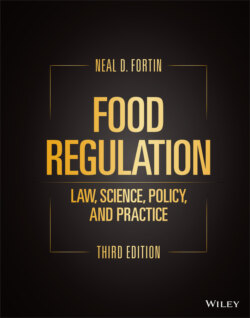Читать книгу Food Regulation - Neal D. Fortin - Страница 283
NOTES AND QUESTIONS
Оглавление1 5.2. Association versus causation. Many epidemiological studies of dietary intake of conventional foods have led to a promising hypothesis concerning a benefit for a particular nutrient only to subsequently be demonstrated via an intervention study that the nutrient‐containing dietary supplement did not confer a benefit or actually was harmful. For example, a number of studies revealed that diets high in fruits and vegetables containing dietary beta carotene were associated with a lower risk of developing lung cancer, particularly among smokers. Beta carotene is known to be an antioxidant and thus provided a plausible mechanism. However, beta carotene intervention trials absolutely dispelled that hypothesis and even showed there was an increase in lung cancer among smokers after they consumed beta carotene dietary supplements. See Alice H. Lichtenstein & Robert M. Russell, Essential Nutrients: Food or Supplements?: Where Should the Emphasis Be? 294 JAMA 351–358 (2005).
2 5.3. Qualifying weak evidence. The claim requested by Pearson, “Consumption of antioxidant vitamins may reduce the risk of certain kinds of cancer,” at that time was considered factually accurate but misleading because of the limits in the evidence. The Pearson v. Shalala court indicated that FDA had “logically determined” that the consumption of antioxidant dietary supplements could not be scientifically proven to reduce the risk of cancer. The court, however, concluded that antioxidant vitamins could nevertheless make a cancer prevention health claim if accompanied by a qualification such as, “The evidence is inconclusive because existing studies have been performed with foods containing antioxidant vitamins, and the effect of those foods on reducing the risk of cancer may result from other components in those foods.” Do you agree with the court that the qualifying statement cured the misleading nature of the cancer prevention claim? Do you think the court understood the nature of the scientific evidence?
3 5.4. Hypothesis versus reliable scientific evidence. Of the four claims submitted in Pearson v. Shalala, three involved evidence supporting a hypothesis—in some cases promising support, but nonetheless, no direct evidence to support the claims. Moreover, even if beneficial effect of a component in the food had been determined, there was no evidence that the component would have the same effect if taken as a dietary supplement. In short, there was no reliable evidence to support the claims. Are consumers able to understand the limitations of suggestive evidence when a claim is qualified? Are claims based on unreliable scientific evidence (evidence that is only suggestive of a hypothesis) inherently misleading? What about a qualification where the claim is more likely than not to be invalid? See e.g., “Green tea may reduce the risk of breast or prostate cancer. FDA has concluded that there is very little scientific evidence for this claim.”
4 5.5. Health and safety. The Pearson v. Shalala court noted that the government did not assert that these dietary supplements “in any fashion threaten consumer's health and safety.” Can you think of a way that misleading health claims might adversely affect consumer health and safety?
5 5.6. First Amendment protection for labels versus articles and books. In Pearson, the government argued that the First Amendment rights of food manufacturers were not infringed because the manufacturers could still make their claims in published articles and books. Is the government saying that a label is so inherently different from published articles and books that a different standard for misleading should apply? If not, what is the government implying? Is there different First Amendment protection for labels than for articles and books?
6 5.7. What did Pearson win? Did the Pearson court authorize the plaintiffs to make their claims? What gains did the plaintiffs make?
